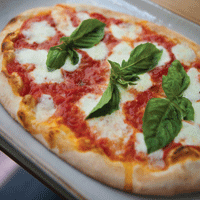Rustic Italian food may be popular, but many chefs are showcasing their creativity by serving up traditional food with a modern twist.
When a group if Italians walked into L.A.B. a few months ago, chef and owner, Howard Dubrovsky, explained — in his best broken Italian — that the food might not be what they expected. The heirloom tomatoes sliced into a caprese salad ($15) with locally produced burrata cheese, for instance, are hickory-smoked with a PolyScience smoker gun. The pasta carbonara ($19) is tossed with smoked beech mushrooms, instead of pancetta, and the bruschetta arrives topped with spheres of basil caviar.
“I was sweating in the back, more nervous with that table than with any of the critics,” recalls Dubrovsky, who opened his Live and Breathe (L.A.B) molecular restaurant in Toronto’s Little Italy nearly two years ago. “They ordered, they ate, and they were happy,” he says. “That was my green light … I felt like I’d arrived.”
The former food stylist and private chef aims to “push” Italian food forward with his high-tech tools, while respecting the cuisine’s classic principles. “We also make food that looks and tastes familiar,” he says, pointing to the menu’s hearty short ribs cooked sous vide in Brio soda ($25) as an example.
While many chefs, Italian or not, are reaching back in time for inspiration — curing their own meat, making fresh cheese and looking for ways to use leftover pig’s blood in their rustic fare — Dubrovsky is one of many churning out modern Italian cuisine.
While many chefs, Italian or not, are reaching back in time for inspiration — curing their own meat, making fresh cheese and looking for ways to use leftover pig’s blood in their rustic fare — Dubrovsky is one of many churning out modern Italian cuisine. But he doesn’t plan to stray too far and create dishes like the pizza with mac and cheese he enjoyed recently in his native Montreal or the tasty pizza in a cone shaped crust from the Mad Italian Gelato Bar in Toronto, produced by using imported Italian equipment.
Even some of our most celebrated Italian chefs are quietly tweaking the classics, using untraditional techniques to express their creativity and appeal to a wide audience. Pino Posteraro, chef and owner of Cioppino’s in Vancouver’s fashionable Yale town, doesn’t need to kill his own pigs to prove he’s trendy. He was making salami with his mother at the age of five when it was a way of life. “We killed pigs to get ready for winter, to feed six kids,” says the Calabria-born chef, who serves a $30 platter of salsiccia, sopressata and lonza (pork tenderloin) house-made and cured from organic pigs raised on Salt Spring Island.
When Posteraro opened Cioppino’s 13 years ago, he chose to call it a Mediterranean grill because there were already so many Italian restaurants. “Sometimes, being Italian doesn’t allow you space to create,” he says. “This way I could.” The results are ethereal. Along with classic osso buco with saffron risotto ($38) and veal scaloppine ai funghi ($32.95), locals and Hollywood stars alike have dined on his rack of lamb from central B.C. with lentils from Umbria and a green curry coconut sauce, reflecting Canada’s cosmopolitan nature. “Why should I come here and do the same conservative food you find in Italy?” he asks. “When you’re in Canada, you should cook like a Canadian.”
His strong classic roots give him the right to improvise, Posterero insists. Though he buys fresh burrata cheese, flown in from the Puglia region of Italy every Tuesday, he’s inspired by the “beautiful” local products that surround him. He fills handmade egg tagliolini with Dungeness crab and a light tomato sauce ($32). He’s particularly proud of his new Sunshine Coast sturgeon dish with a simple Sicilian organic tomato vinaigrette ($40), an example of the lighter sauces Italian chefs have adopted. He experiments with pectin and agar agar as a thickener, and uses rice to keep his lobster bisque ($14.95) velvety and gluten-free for the growing number of customers allergic to flour.
Posteraro is also a master of the French sous-vide technique, which he calls the future of cooking. A rack of lamb prepared sous-vide style cooks evenly on all sides, which is impossible in the oven, he claims. The chops are crisped before serving; he even uses the vacuum technique to make custard for his ice cream.
When celebrated chef Massimo Capra was in Europe this year taping his new TV show, Gourmet Escapes, he discovered most kitchens use sous-vide. “You can cook beautiful fish fillets and keep the temperature so low the texture doesn’t change,” he says. “It’s almost like eating a raw piece of fish, yet it’s cooked through.” Back at Mistura, in downtown Toronto, the mustachioed showman uses the technique to cook beef cheeks for “an incredible texture.”
Like an actor who doesn’t want to be typecast in a particular movie genre, chef Steve Silvestro, hired by Burlington, Ont.-based SIR Corp. to rev up Alice Fazooli’s Italian offerings, is also wary of being labelled. “I don’t want to pigeonhole myself as a classic guy,” says Silvestri, who grew up with an Italian nonna in Guelph, Ont., but headed a fine French kitchen for eight years before joining Fazooli’s last year. His first project, a simpler, cleaner tomato sauce, is selling “big time” in a seafood fettuccine with shrimp, scallops and mussels ($17.95). For Fazooli’s prix-fixe New Year’s Eve menu, he’s offering a smoked tuna carpaccio — beloved by northern Italians — with shaved fennel, arugula and fresh oranges.
“Food goes in cycles, like fashion”
Chris Mills, executive chef at the Vancouver-based Joey restaurant group, has also traded the heavy sauces of the past for olive oil and chicken stock reduced to a glaze. He uses it to complement his newest Italian-inspired dish of garganelli, a traditional egg-based dried pasta from Emilia Romagna, paired with duck confit and sun-dried tomatoes. The $15 dish, expected to appear on menus across the country in January, is finished with butter, lemon and a little starchy pasta water for creaminess, an old Italian trick.
“Food goes in cycles, like fashion,” says Silvestro. “Now we’re seeing pizzerias selling classic Neopolitan pizza. To Italians it’s old news, but it ups the game for everyone here. Now that we know what a real pizza tastes like, we can’t look back, and most people know what fresh or buffalo mozzarella tastes like.”
Quivering balls of fresh mozzarella, imported or produced locally, have indeed captured our imagination. Compare it to the dried yellowed bricks of salty store-bought mozz, and you’ll understand why, says Silvestro, who loves its melting quality and long stretch on pizza and that it stays bright white when cooked.
“People now understand good and bad mozzarella and they can appreciate it when it’s good”
Lorenzo Sibio, president and CEO of the seven-month-old Canadian outpost of the Rome-based Obika Mozzarella Bar, calls it a mozzarella moment. His stylish black restaurant, set in one of Toronto’s most stylish buildings, has attracted Bay Street bankers and tourists alike eager to try its creamy DOP deliciousness that’s flown in twice weekly from Campania, Italy. Sibio is already looking for a second Toronto location, with plans for Montreal and Vancouver. “People now understand good and bad mozzarella,” he says, “and they can appreciate it when it’s good.”
While he’s not enamoured with Obika’s product or execution, a stop at the chain’s New York bar inspired French-trained restaurateur Mike Jeffs to open a mozzarella bar in his year-old 55-seat restaurant, Tavola, in Vancouver’s West End. “We sell tons of it in different ways,” says Jeffs, who likes to channel “the spirit” of Italian food. His bestselling $20 platter includes Italian buffalo mozzarella, which he finds superior to the local version, in addition to two cheeses imported from Gioia Cheese Inc., in Los Angeles. There’s mozzarella’s “dreamy, creamy” cousin burrata, stuffed with cream and curds, and burricotta, a mozzarella pouch stuffed with fresh ricotta. Each cheese has its own accompaniment, from Iowa’s La Quercia prosciutto, which fits nicely in his slicer, to radicchio sautéed with a splash of balsamic vinegar.
Buying U.S. cheese makes sense for Jeffs because “90 per cent of Italian products come to Canada via Montreal or Toronto and get trucked across the country,” he says, “so fresh things don’t work out great.”
New York super chef Scott Conant, owner of Scarpetta restaurant in Toronto’s Thompson Hotel, describes his food as rustic Tuscany meets urban Milan and aims to capture the “soulfulness” of Italian cooking while tweaking and adding elements to keep it interesting. For a twist of flavour, Conant finishes his braised rabbit tagliatelle ($22) with fresh mint. “I find it takes the dish in a different direction,” he says. “It’s just that one little twist people can grab on to. You breathe it all in for a moment — that bit of mint, the roasted rabbit and caramelized roasted parsnips … it’s a lot of flavour profiles bouncing around together that work well.”
Meanwhile, in the Maritimes, Andrew King honours the roots of Italian cuisine while adding his personal touch at long-time favourite Da Maurizio in Halifax, which he’s owned since 2007. Main course pastas, dried and fresh, remain a huge seller, and he’s selling more whole wheat, farro and gluten-free pasta every year. “I find that vegetarians, especially, are looking for more healthy dishes,” he says, citing his whole-wheat linguine with grilled vegetables finished with goat cheese and lemon ($12.95).
It’s a blending of the old and new, a technique that’s winning praise from third-generation Italian customers and their first-generation counterparts who both speak the same culinary language.
Did You Know?
Tomatoes have been a recent source of contention in Italy. Last year alone, police seized hundreds of thousands of the red juicy fruit. Numerous companies were caught trying to make any number of illegal claims, including fraudulently labeling Chinese tomatoes as “Made in Italy” and using labels listing false production method and place of origins declarations.
More in Feature Articles
Making it Big: Extreme Brandz Takes the Lead
A League of Their Own: MLSE Scores Big
The C Factor: Chef Clark Champions the Canadian Seafood Industry
Hot Spot: Profiling Vancouver’s White Spot Resto
House Rules: Profiling Paul Rogalski and Olivier Reynaud of Rouge
The Elephant in the Room – Ventilation and Exhaust Systems
Rise Up: Canadian Wines Shine on Restaurant Menus
Russo Rising: Profiling Chef Russo




















